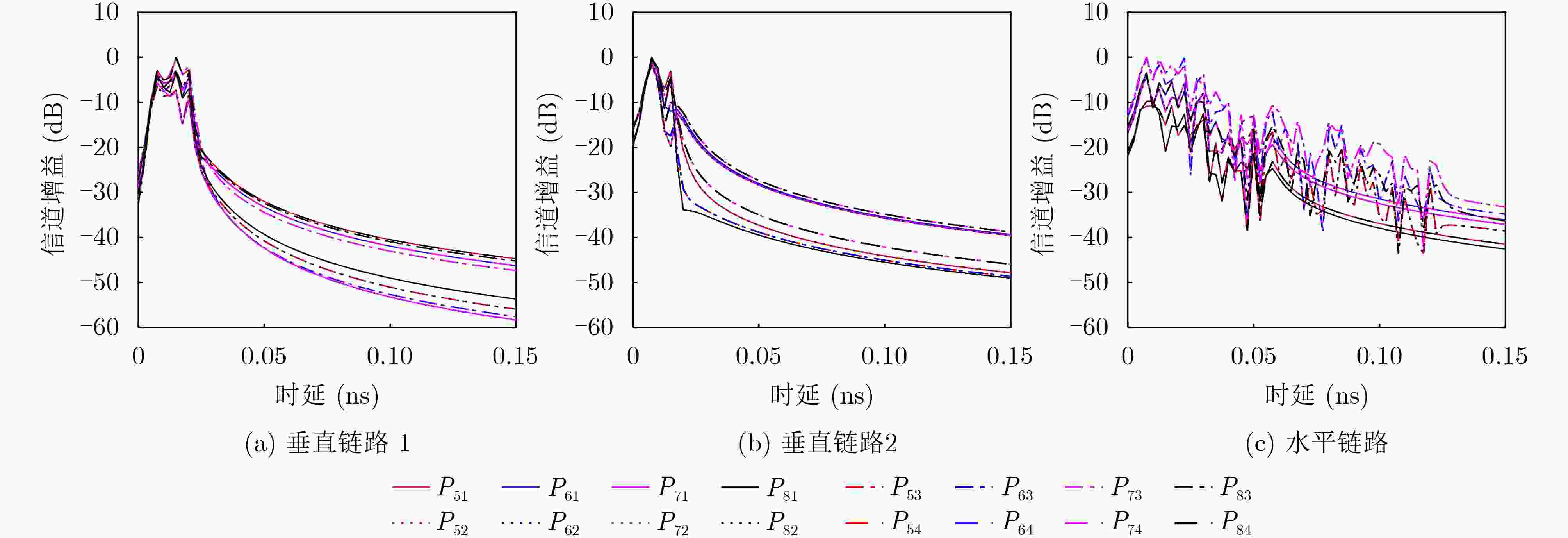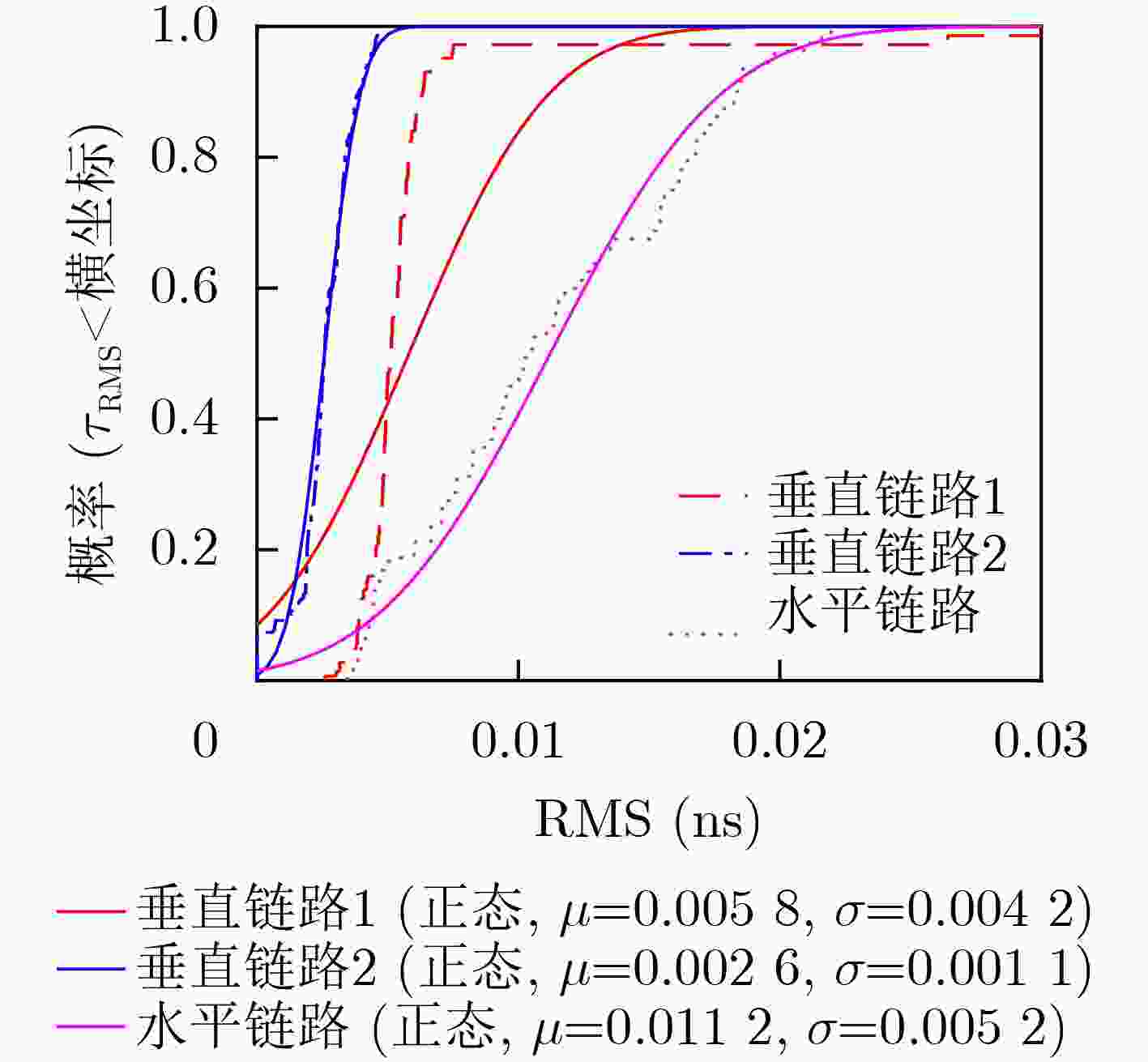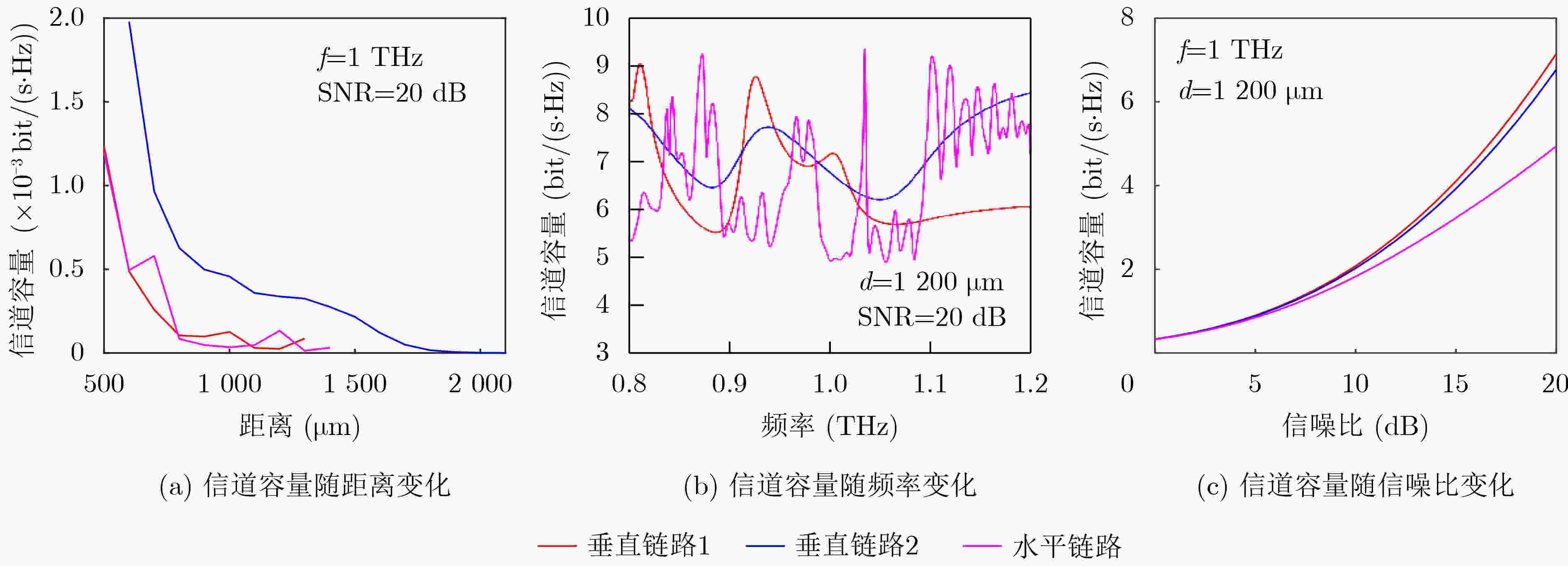In-vivo MIMO Channel Characteristics Analysis and Modeling Based on Skin-fat Model at Terahertz Frequency
-
摘要: 为探究太赫兹(THz)频段体内多输入多输出(MIMO)通信系统的传输特性,该文在0.8~1.2 THz下构建了精确的皮肤-脂肪模型,对皮肤-脂肪模型中垂直方向和水平方向的链路进行全波电磁仿真,分析太赫兹体内信道特性,建立路径损耗模型。首先,结合太赫兹频段人体组织的介电特性和人体皮肤的解剖学结构构建皮肤-脂肪模型。其次,对比分析了3条链路的路径损耗和阴影衰落,提出带有等效吸收因子的太赫兹体内路径损耗模型。最后,对3条链路的莱斯K因子、均方根时延扩展、MIMO容量进行分析。仿真分析表明,带有等效吸收因子的太赫兹体内路径损耗模型可以更准确地描述加长距离垂直链路2的路径损耗,发射端在体表可以增强MIMO容量。该文的工作可以为太赫兹体内通信系统的设计和优化提供参考。Abstract: To investigate transmission characteristics of in-vivo Mmultiple Input Multiple Output (MIMO) communication systems at TeraHertz (THz) frequency, a precise skin-fat model is constructed at 0.8~1.2 THz. Full wave electromagnetic simulations are conducted on the vertical and horizontal links in the skin-fat model, the characteristics of terahertz in-vivo channel are analyzed, and a terahertz in-vivo path loss model is established. Firstly, the skin-fat model is constructed based on the dielectric properties of human tissue at terahertz frequency and the anatomical structure of human skin. Secondly, the path loss and shadow fading of the three links are compared and analyzed, and a terahertz in-vivo path loss model with equivalent absorption factor is proposed. Finally, the Rice K factor, the root mean square delay extension, and the MIMO capacity of the three links are analyzed. The results demonstrate that the terahertz in-vivo path loss model with equivalent absorption factor can more accurately describe the path loss of extended distance in vertical link 2, on-body transmitter can provide enhancement in MIMO capacity. This work can give an insight into the design and optimization of THz in-vivo communication systems.
-
表 1 皮肤各层分界面的A,B参数(μm)
界面 参数A 参数B 1 10 200 2 10 400 3 20 400 4 100 400 表 2 水和血液的双德拜模型
$ {\varepsilon _s} $ $ {\varepsilon _2} $ $ {\varepsilon _\infty } $ $ {\tau _1} $ (ps) $ {\tau _2} $ (ps) 水 78.8 6.6 4.1 10.6 0.18 血液 130.0 3.8 2.1 14.4 0.10 表 3 路径损耗模型的拟合参数
CI 模型 FI模型 CIF模型 ABG模型 PLE RMSE $ \alpha $ $ \beta $ RMSE PLE b RMSE $ \alpha $ $ \beta $ $ \gamma $ RMSE 垂直链路1 6.15 4.52 38.70 3.40 2.42 6.29 0.29 5.89 3.35 4.91 5.10 4.48 垂直链路2 5.35 5.49 17.28 4.91 5.60 5.51 0.66 5.36 4.72 –51.14 10.38 5.39 水平链路 6.48 4.93 37.92 3.87 3.17 6.90 1.08 5.77 4.98 –95.96 18.23 5.25 表 4 3条链路修正的路径损耗模型的拟合参数
修正的FI模型 修正的ABG模型 $ {\mu _{{\text{abs}}}} $ $ \alpha $ RMSE $ {\mu _{{\text{abs}}}} $ $ \beta $ $ \gamma $ RMSE 垂直链路1 $ 5.242 \times {10^{ - 3}} $ 47.02 2.611 $ 6.604 \times {10^{{{ - }}3}} $ 11.59 5.10 4.52 垂直链路2 $ 1.236 \times {10^{ - 2}} $ 32.62 4.741 $ 1.129 \times {10^{{{ - }}2}} $ –36.55 10.38 4.83 水平链路 $ 8.879 \times {10^{{{ - }}3}} $ 47.39 3.259 $ 1.407 \times {10^{{{ - }}2}} $ –80.81 18.23 5.38 -
[1] AKYILDIZ I F, HAN Chong, HU Zhifeng, et al. Terahertz band communication: An old problem revisited and research directions for the next decade[J]. IEEE Transactions on Communications, 2022, 70(6): 4250–4285. doi: 10.1109/TCOMM.2022.3171800. [2] WALTHER M, FISCHER B M, ORTNER A, et al. Chemical sensing and imaging with pulsed terahertz radiation[J]. Analytical and Bioanalytical Chemistry, 2010, 397(3): 1009–1017. doi: 10.1007/s00216-010-3672-1. [3] JORNET J M and AKYILDIZ I F. Information capacity of pulse-based wireless nanosensor networks[C]. 2011 8th Annual IEEE Communications Society Conference on Sensor, Mesh and Ad Hoc Communications and Networks, Salt Lake City, USA, 2011: 80–88. doi: 10.1109/SAHCN.2011.5984951. [4] BUSH S F, PALUH J L, PIRO G, et al. Defining communication at the bottom[J]. IEEE Transactions on Molecular, Biological and Multi-Scale Communications, 2015, 1(1): 90–96. doi: 10.1109/TMBMC.2015.2465513. [5] ABBASI Q H, EL SALLABI H, CHOPRA N, et al. Terahertz channel characterization inside the human skin for nano-scale body-centric networks[J]. IEEE Transactions on Terahertz Science and Technology, 2016, 6(3): 427–434. doi: 10.1109/TTHZ.2016.2542213. [6] ATAKAN B, AKAN O B, and BALASUBRAMANIAM S. Body area nanonetworks with molecular communications in nanomedicine[J]. IEEE Communications Magazine, 2012, 50(1): 28–34. doi: 10.1109/MCOM.2012.6122529. [7] PIRO G, BOGGIA G, and GRIECO L A. On the design of an energy-harvesting protocol stack for body area nano-NETworks[J]. Nano Communication Networks, 2015, 6(2): 74–84. doi: 10.1016/j.nancom.2014.10.001. [8] WANG Bin, XU Ke, ZHENG Shilian, et al. A deep learning-based intelligent receiver for improving the reliability of the MIMO wireless communication system[J]. IEEE Transactions on Reliability, 2022, 71(2): 1104–1115. doi: 10.1109/TR.2022.3148114. [9] HAN Chong, WANG Yiqin, LI Yuanbo, et al. Terahertz wireless channels: A holistic survey on measurement, modeling, and analysis[J]. IEEE Communications Surveys & Tutorials, 2022, 24(3): 1670–1707. doi: 10.1109/COMST.2022.3182539. [10] BERRY E, FITZGERALD A J, ZINOV'EV N N, et al. Optical properties of tissue measured using terahertz-pulsed imaging[C]. SPIE 5030, Medical Imaging 2003: Physics of Medical Imaging, San Diego, USA, 2003, 5030: 459–470. doi: 10.1117/12.479993. [11] HAYUT I, PUZENKO A, ISHAI P B, et al. The helical structure of sweat ducts: Their influence on the electromagnetic reflection spectrum of the skin[J]. IEEE Transactions on Terahertz Science and technology, 2013, 3(2): 207–215. doi: 10.1109/TTHZ.2012.2227476. [12] YANG Ke, PELLEGRINI A, BRIZZI A, et al. Numerical analysis of the communication channel path loss at the THz band inside the fat tissue[C]. 2013 IEEE MTT-S International Microwave Workshop Series on RF and Wireless Technologies for Biomedical and Healthcare Applications, Singapore, 2013: 1–3. doi: 10.1109/IMWS-BIO.2013.6756165. [13] BETZALEL N, ISHAI P B, and FELDMAN Y. The human skin as a sub-THz receiver–does 5G pose a danger to it or not?[J]. Environmental Research, 2018, 163: 208–216. doi: 10.1016/j.envres.2018.01.032. [14] BETZALEL N, BEN ISHAI P, PUZENKO A, et al. Emission from human skin in the sub THz frequency band[J]. Scientific Reports, 2022, 12(1): 4720. doi: 10.1038/s41598-022-08432-5. [15] ABDELAZIZ A, YANG Ke, QARAQE K, et al. Multiple antenna techniques for terahertz nano-bio communication[C]. 2018 IEEE 4th Middle East Conference on Biomedical Engineering, Tunis, Tunisia, 2018: 67–71. doi: 10.1109/MECBME.2018.8402408. [16] ABBASI Q H, ABDELAZIZ A, and ZHANG Rui. Capacity evaluation of in-vivo nano-sensors at terahertz frequencies using multiple antenna techniques[C]. URSI Asia-Pacific Radio Science Conference, New Delhi, India, 2019: 16–19. [17] ELAYAN H, SHUBAIR R M, and JORNET J M. Bio-electromagnetic THz propagation modeling for in-vivo wireless nanosensor networks[C]. 2017 11th European Conference on Antennas and Propagation, Paris, France, 2017: 426–430. doi: 10.23919/EuCAP.2017.7928627. [18] PICKWELL E, COLE B E, FITZGERALD A J, et al. Simulation of terahertz pulse propagation in biological systems[J]. Applied Physics Letters, 2004, 84(12): 2190–2192. doi: 10.1063/1.1688448. [19] REID C B, REESE G, GIBSON A P, et al. Terahertz time-domain spectroscopy of human blood[J]. IEEE Transactions on Terahertz Science and Technology, 2013, 3(4): 363–367. doi: 10.1109/TTHZ.2013.2267414. [20] YANG K, PELLEGRINI A, MUNOZ M O, et al. Numerical analysis and characterization of THz propagation channel for body-centric nano-communications[J]. IEEE Transactions on Terahertz Science and Technology, 2015, 5(3): 419–426. doi: 10.1109/TTHZ.2015.2419823. [21] TANG Pan, ZHANG Jianhua, TIAN Haoyu, et al. Channel measurement and path loss modeling from 220 GHz to 330 GHz for 6G wireless communications[J]. China Communications, 2021, 18(5): 19–32. doi: 10.23919/JCC.2021.05.002. [22] HE Jia, CHEN Yi, WANG Yiqin, et al. Channel measurement and path-loss characterization for low-terahertz indoor scenarios[C]. 2021 IEEE International Conference on Communications Workshops, Montreal, Canada, 2021: 1–6. doi: 10.1109/ICCWorkshops50388.2021.9473756. [23] ELAYAN H, SHUBAIR R M, JORNET J M, et al. Terahertz channel model and link budget analysis for intrabody nanoscale communication[J]. IEEE Transactions on Nanobioscience, 2017, 16(6): 491–503. doi: 10.1109/TNB.2017.2718967. [24] MIAO Haiyang, ZHANG Jianhua, TANG Pan, et al. Sub-6 GHz to mmWave for 5G-advanced and beyond: Channel measurements, characteristics and impact on system performance[J]. IEEE Journal on Selected Areas in Communications, 2023, 41(6): 1945–1960. doi: 10.1109/JSAC.2023.3274175. -






 下载:
下载:














 下载:
下载:
